Falling for Fillets
This morning I ran into Nao Tomii - a Boston area sculptor, bicycle component manufacturer, and recently launched framebuilder. I was excited to see that the roadbike he had been building for himself was now finished: There he was, riding it... in a matching outfit!
Tomii frames are fillet-brazed - a process I've been intrigued by after watching Ian Sutton building Icarus frames in the same workshop occupied by Bryan of Royal H. Cycles. Nao learned fillet brazing from Ian and began making his own frames this year.
Fillet brazing (pronounced kind of like "fill-it") is a lugless method of joining steel tubes together using a heated filler material. The construction, as far as I understand, has the strength of lugged steel. The look is absolutely unique: seamless and "liquidy." Whereas lugs create interruptions at the joints and welds create visible seams, fillets give the impression of one tube flowing into another. There is no beginning or end to the joint and the effect is mesmerising.
It almost looks as if the frame is sculpted, which makes it easy to understand how this particular method would appeal to a sculptor.
To my eye, the streamlined look of the joints lends itself especially well to road/racing bikes - reinforcing the idea that they are light, unencumbered, fast. And on this particular bicycle, this is further reinforced by the "airy" colour.
Lilac-gray and white -
- with strategically placed powder-blue accents (an excellent paint job by Circle A).
The "lighter than air" effect is a clever way to suggest racy qualities without resorting to a traditionally aggressive colour scheme, like bright red. I love it and would like something similar should I ever have a road/racing frame built from scratch, or an old frame repainted.
The pewter headbadge, handmade by Nao, adds just a bit of flourish as the finishing touch to an otherwise minimalist frame. Sigh, I love it. This bicycle is just so perfectly elegant and tasteful.
Nao's frame is what I would consider my size, very similar to my Moser. I rode it in the parking lot very briefly, but would need to lower the saddle a tad and attach my own pedals in order to try it properly. The bike does not have toe overlap, proving once more that this can indeed be achieved with small frames. I look forward to seeing more of Nao's thoughtful and beautiful work in the future. If you'd like to inquire about a frame, his email address is posted here.
What is your take on fillet-brazing? anyone a fan, or own a fillet-brazed bicycle? A labor-intensive process that - when done well - delivers a flawless finish, it is the choice of some of the best custom builders.

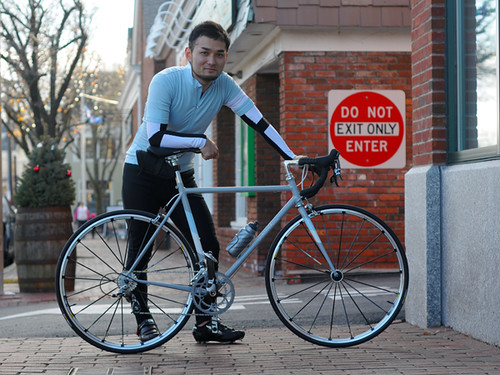
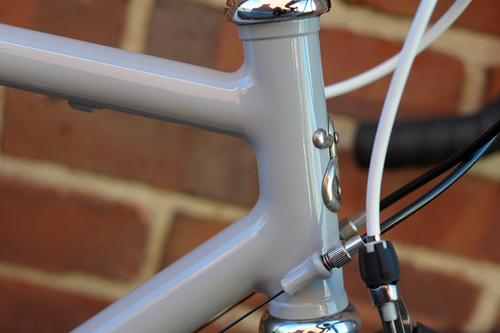
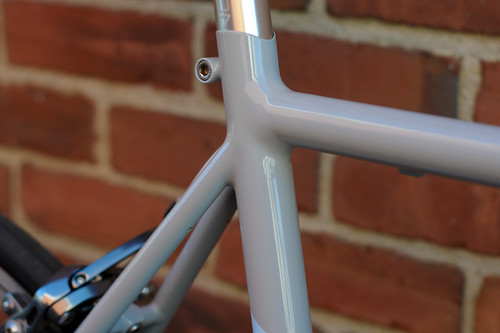



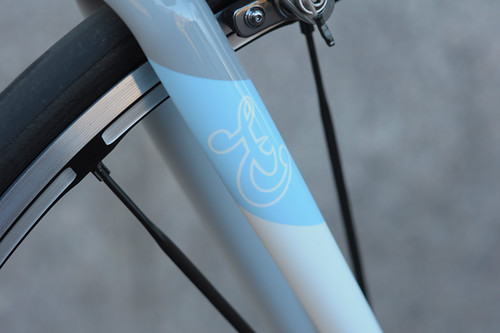

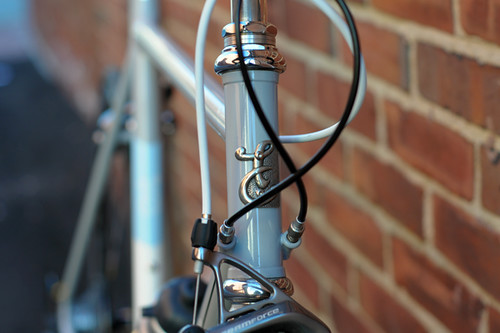
Not an expert at all but this is a very aesthetically appealing bike. Love the lines and the neatness of the seamless brazing.
ReplyDeleteAny FMV or retail figures?
A lot to like with this bike. Love the smooth joints. But I think the stem/headset/fork has some odd angles, doesn't look straight through the three parts to me. And for a steel frame, esp. with the classic stem, I'd like to see some curve in the front fork above the dropouts. That's really nitpicking. Its a beautiful bike.
ReplyDeleteHm. Well it's pretty.
ReplyDeleteI'm not understanding the geo to achieve no tco. Seems like the combo of little set back, short stem and slack hta might make for weird handling, but what do I know.
As far as fillets, eh. I'd rather the frame ride right than be concerned how it's joined.
Gorgeous bike! The headbadge is divine, no doubt.
ReplyDeleteours was made in the early 80's and it's held up beautifully for three decades.
ReplyDeletehttp://www.flickr.com/photos/61932626@N07/6359337993/in/photostream
even has similar colors to nao's beautiful bike.
That is a piece of either rideable jewelery or artwork take your pics Lovely bike for sure. As far as my take on it? Just have to say nothing worse than an ugly weld on anything or brazing for that matter
ReplyDeleteI always felt fillet brazing looked beautiful on the old schwinns I once had. Too bad they were tanks and the smooth brazing didnt always carry over to other parts of the frame.
ReplyDeleteThat airy color is very subtle. Whenever I ride a bike with similar color schemes I always feel as if I blend easier into the urban/ city landscape and I won't be as visible to drivers. I do however feel more comfortable locking up a bike that appears to not be there
I love fillet brazing. Currently having a frame made using this method.
ReplyDeleteAlso, I think you should stop worrying so much about toe overlap. It's only an issue at very low speeds, and is easily dealt with. I'm pretty short, and every bike I own has overlap. No dramas.
Quite a looker. I like that brazing, too!
ReplyDeleteIs that a unicrown fork I see, V? How do you feel about it on this type of bike, with the brazing the way it is?
I chose my custom to be fillet brazed as a way of adding detail to strange geometry that was unsuitable for lugs. Also chose a pastel colour to highlight the curves and smoothness rather than a bold metallic. Just waiting for it to be delivered....
ReplyDeleteAnd there is a Crows Foot lacing variant on the rear wheel as well, with some sort of aerospokes, very nice.
ReplyDeleteThe bike looks exceptionally nice. I even thought that I should buy a fillet brazed frame. Is the fork built with a Cinelli crown?
ReplyDeleteBecause of you, last week, I went down to the basement and put two of my bikes in the repair stand, clipped in a shoe, and turned the wheel. One did not have tco, but one did. I have ridden both bikes since the 1980s and did not know. I do not know how I don't touch the wheel with my toe, but I don't.
New to this site. Very nice, I'll be back! I own a Rich Adams fillet brazed bike, made with Columbus Zona. Nicest riding bike I have ever owned (and I have owned many high end bikes), now with over 5000 miles since last year. Stiff, lively, surprisingly light.
ReplyDeleteCan't you just get the identical effect with polished welds?
ReplyDeleteVERY gorgeous frame he builds!
ReplyDeleteDisabled Cyclist
'The look is absolutely unique'
ReplyDeleteExcept of course for all the other fillet brazed bikes there have been.
My sister's Peugeot from the late 1980s is fillet brazed.
Nao is a good guy and I have been looking forward to his bikes :)
ReplyDelete"Boston by bike" You can file a TIG weld down smooth [I have done this many times], but it will never have enough material to make as seamless as a brass filled joint. And it is not a good idea to try make a TIG weld as big as a brass fillet to get the same affect [to much heat a damage to the tube].
pete - "The look [of fillet brazing] is absolutely unique," I wrote. That includes both this bike and your sister's Peugeot.
ReplyDeleteI really like the look of fillet brazed, much more so than ornated lugs. What kind of fork construction do you think is best esthetically suited to fillet brazed frames? I think lugged crown fork would look out of place here.
ReplyDeleteMarcin
Marcin - a sloped fillet brazed fork crown! I love the look of them.
ReplyDeleteI'm drooling just by looking at the fillet brazings alone lol.
ReplyDeleteHi,
ReplyDeleteA thoughtful and informative review. Especially appreciated by one, (me) not in the know. I like your "lighter than air" take. Sweet color.
I met Nao at a BRW meeting a while ago, and he was riding a perfectly accessorized Soma Fab bike, for which he'd cut a custom head badge. Great sense of color, proportion and design. Great to have another frame builder around!
ReplyDeleteNao san's work is amazing for a first-timer. They say fillet brazing is the most technically demanding way to build a frame. I imagine it is probably the most unforgiving. It is definitely a fetish of mine. The constructuer Jo Routens built gorgeous frames that were fillet brazed. And my beloved Viscount Aerospaces are both fillet brazed.
ReplyDeleteBut even my beloved Viscounts pale into insignificance (did I just say that?) when compared to the brazing on these aluminium framed Barras. Scroll down for several of them, and one very nice Giles Berthoud fillet brazed steel frame. (Can you believe the ONE GUY owns all these?)
http://tinyurl.com/779r2m6
Careful NSFW. Or at least beware of the potential for embarassing and completely involuntary noises of appreciation being misinterpreted. b
Oh and re the toe-overlap issue: have you tried pedalling with slightly (downward) pointed toes? Can you do that with Power Grips? You certainly can with clips. ;) b
ReplyDeleteNao did a wonderful job on this bike. And I just love his headbadge!
ReplyDeleteThe color is sublime, and I dig the flowing fillet brazing. As a side note, some builders use a combination of lugged and fillet brazed construction (known as "bilam"), and Singer was known to do this on some of his bikes.
TCO is also somewhat relative to shoe size, so to say there is no TCO on this bike with Nao's shoe size is not to say that there wouldn't be with a shoe sized a size or two larger, or even with different placement of the cleats. Some riders prefer to have the cleats farther back, placing the shoe farther forward on the pedal. This will increase the risk of TCO.
To me, fillet-brazed frames resemble too closely cheap welded steel frames. I know the workmanship and quality are completely different, but my eye's reaction to the joint is -- heavy, heavy.
ReplyDeleteThe frame is very pretty, but to me the wheels destroy the aesthetic of the bike. The whole "lighter than air" theme is contrasted with the massive looking black aerospokes and black contrasts on the rim.
ReplyDeleteI'm also very curious about the somewhat odd looking geometry -- I hope you'll get the chance for an extended test ride.
Forgive the beginner's question, but can someone explain the difference between TIG welding and fillet-brazing? Aren't they both just welding two pieces of metal together without a lug?
ReplyDeleteAgain, beginner here.
That is a beautiful bike, V. Thank you!
ReplyDeleteThe undisputed king of fillet brazing is Tom Ritchey. I am lucky enough to own and ride one of his fillet brazed road frames and one of his fillet brazed tandems. I published an extensive interview with him last year on my blog, and it includes photos of an unpainted fillet brazed frame he'd just made:
http://www.xo-1.org/2011/01/tom-ritchey-in-his-own-words.html
Love this beautiful bike, love the "liquid" joints (well put V), and I am partial to black spokes (I have wonderful black bladed Mavics on my Soma).
ReplyDeleteBut I am *really* loving the lack of toe overlap. In my own biking, it is virtually never a problem on say the W&OD trail (DC area) or on back roads, but with the urban biking I do it's something else I have to think about that I'd rather not. I'll be looking for this in my next bike.
Love that look. The old schwinns (like my moms 1972 collegiate) have a similar seamless look at the joint and I think they are some of the prettiest bikes ever made.
ReplyDeleteNice!
ReplyDeleteTom Ritchey's fillet brazed frames, which date to the early days of mountain biking, are legendary. Glad to see this labor intensive technique still in use.
MT Cyclist
XO-1
ReplyDeleteOh yes Tom Ritchey is a master and good to read that he's still hands-on.
A few other masters:Norman Taylor (of Jack Taylor), Eric Estlund (Winter Bicycles), Bill Philbrook, nameless hands who did all those luscious Claud Butlers and Hirondelles. There are more.
Anon 1:18
The smooth curves on a Collegiate are actually castings. You'll find a buttweld a bit away from where the junction appears to be. On the Super Sport, Superior, Sports Tourer and a few more if you go wayback Schwinn did fillet braze, usually with the addition of an internal sleeve. It's fun to look at those, some are crude production work, some as good as anything.
Lugless frames were available after WW2, Claud Butler and Jack Taylor were two frame builders that offered them. As far as I'm aware these frames were sif-bronze welded. Photo of a 1952 Claud Butler built Saxon Twin tube here:-
ReplyDeletehttp://www.flickr.com/photos/75395133@N00/1288943954/in/photostream
These frames have their following and some reckon they are more responsive than a lugged frame. By the way Velouria above mentioned a Peugeot. Peugeot frames were lugged - the lugs were inside the tubes and was a manufacturing method perfected by Peugeot.
The difference between fillet-brazing and TIG welding is that fillet-brazing isn't a weld at all. While with TIG you take two pieces of steel or other metal and melt them into one, fillet instead takes a different type of metal (usually brass/bronze depending on who you talk to) and melts it around the joint. So its more like gluing than welding if that makes sense. Since the melting temperature for brass is much lower than for steel, the steel maintains its shape while the brass molds around it.
ReplyDeleteTalking to folks with frame building experience and based on my own work, fillet-brazed with brass is often considered to be on par with lugs depending on who is holding the torch. What is interesting is that when silver is used instead of brass as a fillet, it is possible to make a stronger joint than usual. Silver has a much lower melting point, so the strength of the steel isn't as compromised. However when silver is melted, it flows a lot more than brass making it rather difficult to build up into a proper fillet. That's why it's preferred for lugging. It takes a pretty experienced frame builder to do a good fillet with silver.
This doesn't mean that TIG or lugging are weak or inferior, but it is interesting to think about...
holy crap, that thing is AH-MA-ZING!!
ReplyDeleteXO-1
ReplyDeleteNice blog. Great interview. Thanks.
Mmm.... much as I love lugs, this is a beautiful way of brazing which takes the ugliness away from brazed joints. What a heavenly bike!
ReplyDeleteHello guys, My name is Nao. Thank you so much for the great pictures, Velouria :) and thank you for a lot of comments :) This is my first bike and build with my teacher. Yes, the geometry looks little funny with the short stem. I choose pretty relaxed geometry and I always use short stem (I am weird.. haha..) I got the old tubeset from peter moony and my teacher gave me the fork crown, so it was not much choice. (I love the curved fork also!) I originally build with old campy parts, but I put sram parts to try how the new stuff fells.(Quill stem with new components looks funny)http://www.flickr.com/photos/3rrrproducts/5851305918/in/set-72157626346899889 I just finished my second frame. It's a Single Speed city frame. http://www.flickr.com/photos/3rrrproducts/sets/72157628255434261/ I am very new to frame building and I like to know what other people think. (good things and bad things:) So, please tell me! :) Thanks again! Nao
ReplyDeleteThanks for the explanation Christopher. I really appreciate it! So much to learn...
ReplyDeleteHey Nao (!)
ReplyDeleteIf this is your personal bike and you like the way it rides, it doesn't need improvement.
If you're building for others you may want to ride/study small popular bikes that people like with respect to geometry.
I looks like you like a high forward seat and a short stem, a position that isn't ideal, particularly for a custom frame.
Mostly it's a long learning process to fit a rider properly; the fabrication skills you clearly possess.
I wouldn't kick it (it, the bike she presents above) out of bed. I like the paint and the tight geometry esp, the straight fork...as if it really wants to get out there and play.
ReplyDeleteDon't like the black spokes with those rims, though.
Thanks for commenting Nao : )
ReplyDeletep.s. I'm a big fan of smaller wheel sizes for smaller frames. This is often a better solution for dealing with toe-overlap than lengthening top tubes or making the seat tube angle more aggressive. The curves on the fork blades for single speed also act as a form of suspension, which makes for a more pleasant ride.
ReplyDeleteLooks great!
Tom Ritchey frames still set the standard for fine craftsmanship in a fillet brazed work. I've owned two of his bikes and still hope someday to find a road frame by him.
ReplyDeleteChris' interview with him, and the photos, are worth repeating:
http://www.xo-1.org/2011/01/tom-ritchey-in-his-own-words.html
The disturbing thing about fillets is that with enough time the worst abomination of torch work can be made pretty with enough time filing and smoothing it.
ReplyDeleteAn aesthetically pleasing tig weld can only be done by someone with experience.
yes, yes, very true. Heat control is very important for brazing. High heat damage the tube. Also I have to very carefull when file the joints. I have seen some people using bond to hide the ugly fillet work.... :(
ReplyDeleteStill very difficult to cotrol the heat for me, but I am really enjoying using frames :)
I love the beautiful tig welding beat also:)
You did a great job with the filing, nice and clean.
ReplyDeleteNao-San, this is beautiful, in may ways harmonious work. Please continue.
ReplyDeleteCorey K
Wow. Bikes like this are why artsy people like me get all stupid once in a while and decide to learn framebuilding(or shoemaking or furnituremaking or stonemasonry...UGH.). Such a well designed and executed thing.
ReplyDeleteI really like fillet brazed frames but I don't think they look right on a roadracer for some reason. There are a couple of old Ritchey Mountainbikes in my basement that belong to someone else that are fillet brazed and they are sooo cool. One of them(a P-22) was used to win a couple of NORBA veteran cross country championships in the late 80s so it works pretty well.
One nice thing about fillet brazing is that you can build super strong joints without having to be a master craftsman capable of making those perfectly shaped, liquidy looking joints. It was the method of choice for years in building airplanes and racecars and anything else that required lightweight steel construction. If you ever get the chance to look under the skin of a late 40s to early 60s grand prix or sportsracing car you'll see lots of it. A Maserati tipo 61 "Birdcage" got it's name from being a fantastically complicated mess of small diameter tubes hiding under some scraps of hand beaten alloy skin. The actual joints were usually pretty lumpy and rough but it was a better method for that sort of thing than the available welding options. Tig welding has taken it's place in those disciplines now but you still see it being done. I really enjoy brazing but usually resort to Tig or Mig welding because there's about 95% less clean-up (and I'm sorta' lazy).
Spindizzy
The comment about the old Schwinn frames having cast joints isn't quite accurate. In that case the joints were made with stampings. Sheet steel was shaped around a form and the resulting "Lug" was electrically butt-welded to the tubes.
ReplyDeleteSchwinn wasn't the only manufacturer to use some variation of this technique but they were the most prolific by far. It's actually a really superior method but it doesn't lend itself to thin tubing or small batches. It also requires better tubing than alot of manufacturers were willing to buy. It's a shame that most of those old Schwinns don't have very practical geometry for serious riding because the bikes themselves were really well designed and built with care. I can use a really nice 35 pound bike but not if it don't fit.
Spindizzy
A number of English builders used the technique in the 1950’s.
ReplyDeleteI owned a beautiful Gillot built in 1954. Reynolds 531 double butted
Tubes, 75 degree parallel, with track ends. I used it for fixed wheel time trailing until the early sixties. These frames are much sought after in the UK, in good condition they fetch twenty or thirty times there new cost.
I think the Gillot cost £12 10shillings new in 54. I paid £9.00 for it in 1958.
It is marvellous to see the revival of craftsman bespoke building in the US. There a few builders left in the UK and a few in Italy but the future lies I think in the US.
I will be building a new bike for next season and I am seriously thinking of ordering the frame from a US builder is probably going to be my last bike. I have been cycling for 61 years so I think I know what I want this time. Love your blog.
Philip Foster
Hi Spindizzy
ReplyDeleteThey're electro-forgings. Since that one never tripped lightly off any tongue they get called most everything. Though you are much closer to accuracy than I. Always disliked calling them stampings because of the connotations of "cheaply, quickly stamped out". Which was not the case at all.
This moved me to take a look at the '58/59 Spitfire I've owned since new (gave it away many times, it came home). The welds at the headtube are good enough that you wouldn't find them if you didn't know. Almost as good at the bracket for the main tube joins. Chainstay joins are rough but still far better than what's remembered from 70's Schwinns. And this is a juvenile bicycle.
Fillet braze has another great feature. Most builders need time to create the liquid look and charge as much for fillet as for a lugged frame. Some even charge more. That establishes a price. So when someone like Norman Taylor or Tom Ritchey comes along who can lay down a perfect one pass bead it becomes one of the very very few opportunities any framebuilder has to make any money. Framebuilders all work insanely hard, someone very well should make some money.
Is it only me who's worried about the very concept of a frame which is 'glued together'? Strikes me that this is just a form of soldering, which is notorious for its poor aging characteristics and proneness to dry joints. OK, the metals are different but I'll guarantee that flux is involved and with it the possibility of a bad joint. The actual metal contact area must also be pretty small, but is highly loaded on er.. brass. Good luck! Surely those on here who worry about their carbon forks crumbling beneath them must have considered this?
ReplyDelete@Anon 6:48PM, I think the answer to your first question is "Yes". b :)
ReplyDeleteHmmm in that case I wonder if carbon bikes were as pretty as the one above there would be less fretting and worrying :)
ReplyDeleteSteve
@Steve, I think there ARE people who think crabon bikes are pretty (probably few around here though...). The fretting and worrying comes more from crabon's unknown (so far, fairly short) useable life, and the fact that when it fails it does so catastrophically.
ReplyDeleteFWIW when Viscount first came out with their Aerospace bikes, they had to overcome this perception about 'not having lugs=weak'. So they did a lot of destruction testing and, like any good weld, the tubing failed before the joins did. b
I think fillet is a stronger hold, but harder to repair, since the tubes cant slide out. I just had a custom frame made by Dale Saso in San Jose and his brilliant insight led me to receiving a frame with lugs at all joints except the bottom bracket, which was meticulously fillet-brazed.
ReplyDeleteI wanted lugs simply because I think they are little works of art, but when he was sizing me, he also asked me to ride up the hill he lives on while he watched, and determined that I had too much power to deal with a lugged BB, and asked if fillet brazing will be fine. It was an excellent catch and I couldn't be happier with the work, now having the best of both worlds. I've seen some other amazing work by him in which he uses filed-down lugs only as accents on the head tube, while still fillet-brazing the joints, creating a smoothness with a little bit of flair.